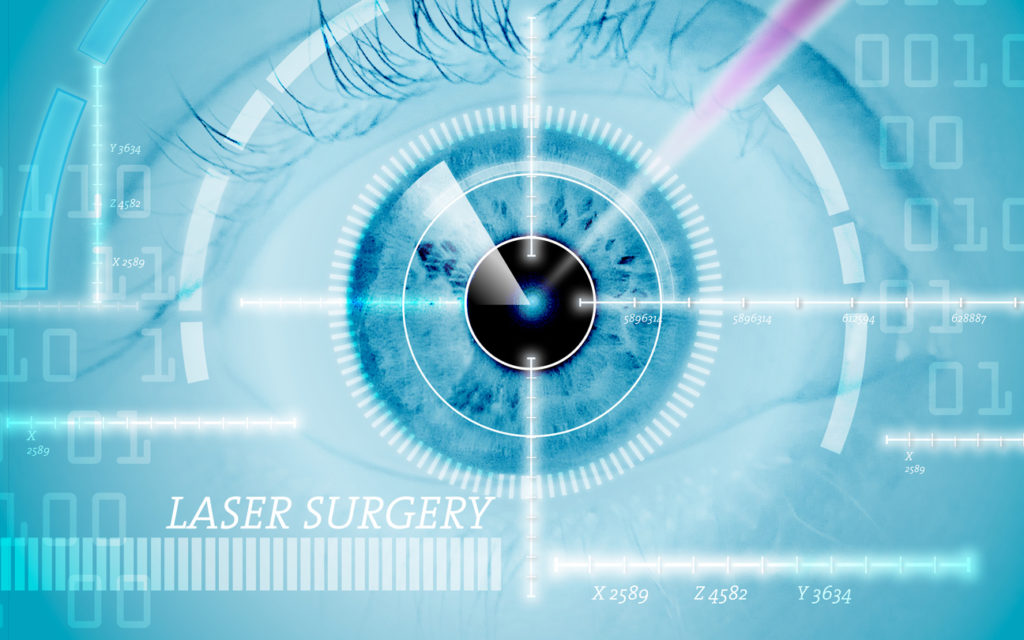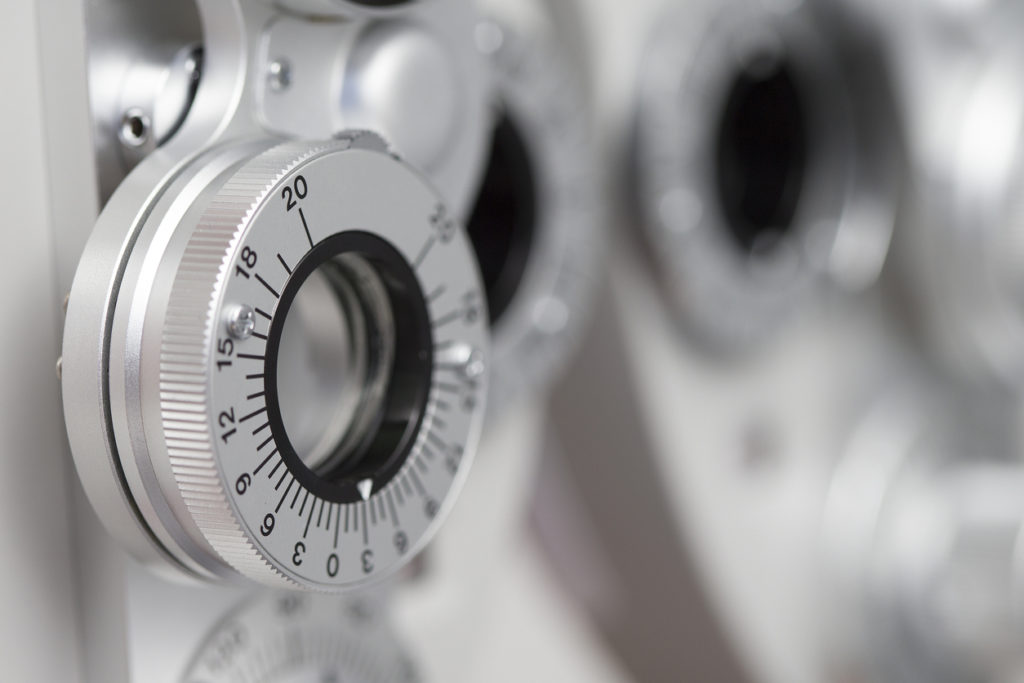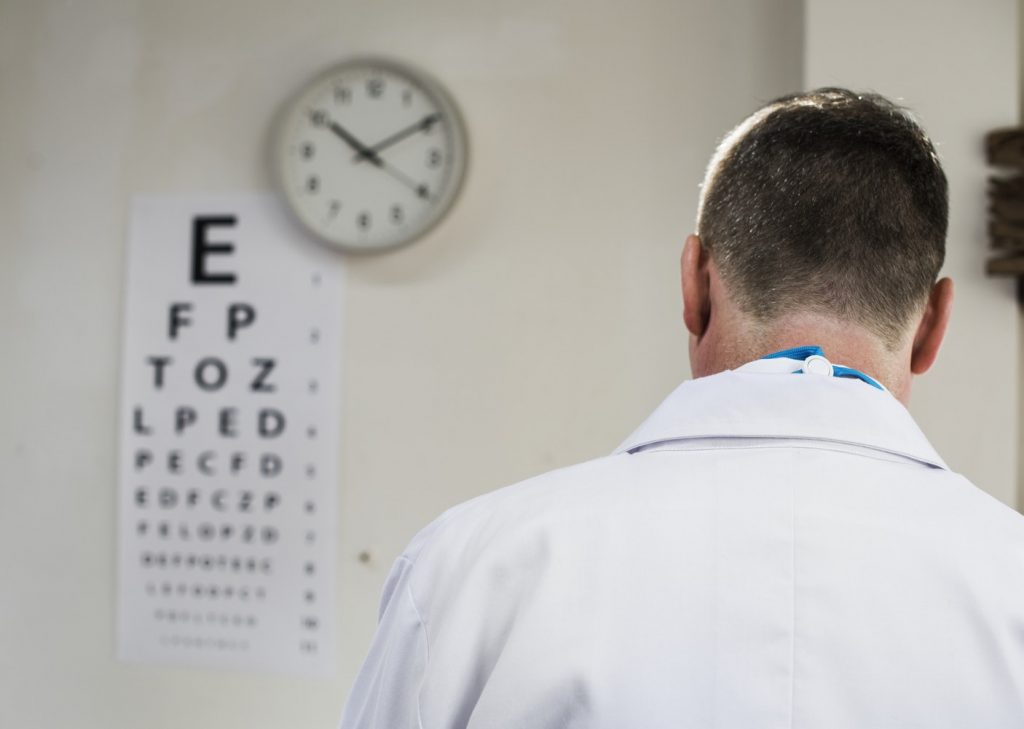Anatomy of the eye
The eye is the organ that allows us to see. The eyeball itself is a sphere spanning approximately 24 mm in diameter. It is suspended in the bony socket by muscles controlling its movements, and is partially cushioned by a thick layer of fatty tissue within the skull that protects it during movement.
The eyes move symmetrically (in the same direction at the same time). These symmetrical movements are made possible through the coordination of the extraocular muscles (muscles outside the eye).
Since the eyes are paired structures, the brain receives two slightly different images that overlap with one another. Interpretation of the different images is possible via coordinated eye movements achieved by complex neural mechanisms. Humans are also able to perceive three-dimensional images because they possess binocular vision, which enables the perception of depth and distance.
The eyeball consists of three main components:
- The tunics, which are three layers that make up the wall of the eyeball
- The optical components, also known as the refractile media components, which admit and focus light
- The neural components, which consist of the retina and the optic nerve. The retina is also part of the inner tunic
Layers (tunics) of the eye
The tunics of the eye consist of the following three layers:
Tunica fibrosa
Tunica fibrosa refers to the outer fibrous layer of the eye. This includes the sclera and the cornea, which are continuous with one another.
- Sclera: The sclera is the white part of the eye, and covers most of the eye surface. It is made up of a dense tissue which has a rich supply of blood vessels and nerves, and provides attachment for the external muscles of the eye. The sclera tends to have a slight blue tinge during childhood because of its thinness. It also can appear yellow in the elderly due to the accumulation of a pigment associated with age-related wear and tear in the tissue.
- Cornea: The cornea allows light to enter the eye, and can be thought of as being part of the modified sclera.
Tunica vasculosa
Tunica vasculosa refers to the middle vascular layer. This is also called the uvea. The uvea is made up of the choroid, ciliary body, and iris.
- Ciliary body: The ciliary body forms a muscular ring around the lens. It secrets a fluid called the aqueous humour, and supports the iris and lens. The ciliary muscle, which is a smooth muscle responsible for lens accommodation, is contained within the ciliary body. Contraction of the ciliary muscle enables the lens to focus light onto the retina by changing its shape.
- Iris: The iris is an adjustable thin muscle controlling pupil diameter. It consists of two layers – one that blocks stray light from reaching the retina, and another containing cells called chromatophores which contain a substance called melanin. The concentrations of melanin within these chromatophores give rise to eye colour. High concentrations of melanin give the iris a black or brown colour. When there is scarce melanin, light reflects from the epithelium of the posterior pigment, giving the iris a blue, green, or grey colour.
Tunica interna
Tunica interna refers to the innermost layer. This layer is made up of the neural components – the retina and optic nerve, which are discussed later under Neural components of the eye.
Chambers of the eye
The three layers of the eye, along with the lens, act as boundaries for the three chambers within the eye:
- Anterior chamber: This is the space between the cornea and the iris.
- Posterior chamber: This is the space between the iris and the lens.
- Vitreous chamber: This is the space between the lens and the retina.
The eye can also be divided into its anterior (front) and posterior (back) segments. The former consists of the cornea, as well as the anterior and posterior chambers and their contents.
The posterior segment contains the vitreous chamber, the visual retina, retinal pigment epithelium (RPE), posterior sclera, and the uvea.
Optical components of the eye
The optical components are transparent elements that admit, bend, and focus light onto the cells of the retina to form images. This occurs through the process of refraction, so the optical components are also known as refractile media components.
These components are:
The cornea
The cornea acts as the main window of the eye. This is the major refractive element of the eye.
Aqueous humour
The aqueous humour is a watery fluid in the anterior and posterior chambers that is secreted by the ciliary body. Its role in refraction is relatively minor, but it is important in providing nutrients to the lens and cornea, which do not have the means to support themselves, and are the two critical refractile elements.
The lens
The lens is second most in importance to the cornea in the refraction of light rays. It is elastic, so that the shape of the lens can undergo minor changes in response to tension of the ciliary muscle. Tension on the muscle flattens the lens, whereas it relaxes into a more spheroid shape when it is not under tension. These changes allow for accommodation to allow proper focusing on near objects.
Vitreous body
The vitreous body contains a fluid component called the vitreous humour. The vitreous body acts as a shock absorber that protects the retina during rapid eye movements and helps to maintain the shape of the eye. In addition to refracting light, it also helps maintain the position of the lens and to keep the neural retina in contact with the retinal pigment epithelium.
Neural components of the eye
As previously mentioned, the neural components of the eye are the retina and the optic nerve.
Retina
The retina is a cup-shaped outgrowth of the brain. It is a thin transparent membrane attached at two points – the optic disc, where the optic nerve leaves the rear of the eye, and the ora serrata, which is the junction between the retina and the ciliary body. It is smoothly pressed against the rear of the eyeball due to pressure coming from the vitreous body.
A detached retina can result from blows to the head or inadequate pressure from the vitreous body, and can cause blurry areas in the field of vision. Since the retina normally attaches to and depends on the choroid for oxygen, nutrition and waste removal, prolonged detachment of the retina from the choroid can lead to blindness.
Macula lutea
A patch of cells about 3mm in diameter can be found in the retina, known as the macula lutea. In the centre of this patch is a small pit called the fovea centralis, which produces finely detailed images.
The optic disc is found close to the macula lutea, and is the point on which nerve fibres from all regions of the retina converge on. These nerve fibres then exit the eye to form the optic nerve, so that the neural retina is continuous with the central nervous system through the optic nerve.
Neural retina
The neural retina contains light-sensitive receptors and complex neural networks, and the retinal pigment epithelium (RPE). It consists largely of photoreceptor cells called retinal rods and cones. Visual information encoded by the rod and cones is sent to the brain via impulses conveyed along the optic nerve.
Pupil
The pupil, which looks black because of the heavily pigmented back of the eye, changes size to control and regulate the amount of light passing through the lens to reach the retina.
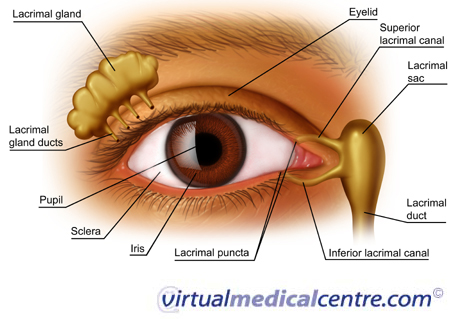
Book your health appointments online
Find and instantly book your next health appointment with Healthengine
Accessory structures
Conjunctiva
The conjunctiva refers to the lining of the eye. It helps lubricate the eye by secreting mucous and tears, and serves as a protective barrier again microbes. It contains many goblet cells which secrete a component of the tears that bathe the eye.
Eyelid
The main function of the eyelid is to provide the eye with protection. The skin of the eyelids is loose and elastic, allowing for movement. There are several types of glands in the eyelids, including tarsal glands that produce a sebaceous secretion that results in an oily surface of the tear film to prevent the evaporation of the normal tear layer.
Eyelashes
Eyelashes are short stiff curved hairs that may occur in double or triple rows. They function to protect the eye from debris. Lashes may also have different lengths and diameters to one another.
Lacrimal gland
The lacrimal glands are the sites of tear production. Tears function to keep the conjunctiva and corneal epithelium moist, and wash away foreign material from the eye. The film of tears covering the corneal surface is a mixture of proteins, enzymes, lipids, metabolites, electrolytes, and drugs (secreted during therapy).
Extraocular muscles
Extraocular muscles (muscles outside the eye) allow the eye to move within its orbit. Six of these eyeball muscles attach to each eye. The actions of these muscles of both eyes are coordinated to enable the eyes to move in parallel, a phenomenon known as conjugate gaze.
Vision
Light
The amount of light entering the eye is controlled by the iris, which is a thin pigmented smooth muscle with different individual characteristics. These form a unique pattern in each individual, so that it is possible to use the iris as a means of identification that is more foolproof even than fingerprinting or DNA testing.
Light enters through the pupil in the centre of the iris. The size of the pupil is adjusted by variable contractions of the iris muscles to control the amount of light entering. The iris contains two sets of smooth muscle networks, one circular (in a ringlike fasion), and one radial (projecting outward).
The pupil becomes smaller when the circular muscle contracts and shortens in response to bright light, so as to decrease the amount of light entering the eye. Under dim conditions, the radial muscle shortens, increasing the size of the pupil.
Light rays are divergent (spreading outward), and must be bent inward to be focused back into a point, known as the focal point, on the retina which is light-sensitive, in order to produce an accurate image of the light source.
Refraction
Refraction refers to the bending of a light ray, and occurs when the ray passes from a substance of one density to a substance with another density. The greater the difference in densities, the greater the degree of bending and hence refraction.
The degree of refraction also depends on the angle at which the light strikes the second substance – the greater the angle, the greater the refraction. With a curved surface such as the lens, greater curvature results in greater degrees of bending, and therefore a stronger lens.
A convex surface curves outwards while a concave surface curves inwards. Convex surfaces converge light rays, bringing them closer together. Convergence is essential for bringing in image to a focal point; therefore the refractive surfaces of the eye are convex.
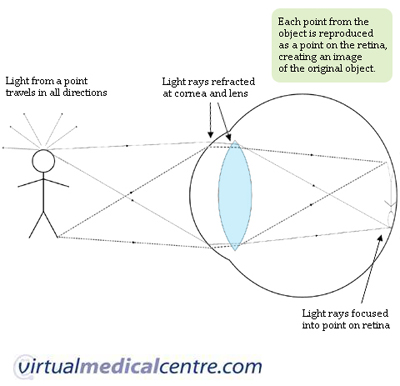
Cornea and lens
The cornea and the lens are the eye’s most important refractive structures. Light first passes through the cornea, which has a curved surface. The cornea contributes the most to the eye’s total refractive ability because the difference in density at the air/corneal surface is much greater than the differences in density between the lens and the fluids surrounding it.
Rays from light sources more than about 6 metres away are considered to be parallel by the time they reach the eye, while light rays from closer objects are still diverging when they reach the eye. For a given refractive ability of the eye, it takes a greater distance behind the lens to bring the divergent rays of a near source to a focal point than to bring the parallel rays of a far source to a focal point. However, the distance between the lens and the retina is always the same in a particular eye. The strength of the lens is therefore manipulated via a process called accommodation.
Accommodation
Accommodation refers to the ability to adjust the strength of the lens by changing its shape, which in turn is regulated by the ciliary muscle. When the ciliary muscle is relaxed, the ligaments (bands of tissue) attached to the lens pull the lens flat and therefore less curved and weakly refractive.
Contracting the ciliary muscle reduces the tension in the ligaments, so that the lens assumes a more curved shape because of its elasticity. The greater curvature allows the lens to increase its strength, resulting in greater bending of the light rays. Therefore, in far vision, the ciliary muscle is relaxed and the lens is flat, but during near vision, the muscle contracts and allows the lens to become more convex.
Phototransduction
Vision occurs through the process of phototransduction. Phototransduction is the conversion of light stimuli into neural (brain) signals by the retinal cells. The cells that perform this function are known as photoreceptors (also called rod and cone cells) and consist of three parts:
- Outer segment, which is closest to the exterior of the eye and detects the light
- Inner segment, which is in the middle and contains the components necessary for the cell’s basic functions to survive
- Synaptic terminal, which is closest to the interior of the eye. It transmits the signal, which is generated in the photoreceptor, to the bipolar cells upon light stimulation.
The outer segment of the eye contains over a billion light-sensitive molecules. Photopigments are substances that undergo chemical alterations when activated by light. They are made up of two components, called opsin and retinene. Retinen is the light-absorbing part of the photopigment.
Photopigments
There are four types of photopigments, one in the rods and one in each of three types of cones. Each type of photopigment absorbs a different wavelength of light.
The pigment in the rods is called rhodopsin. Rhodopsin absorbs all visible wavelengths, so that rods provide vision only in shades of grey by detecting different intensities rather than colours.
The three types of cones – red, green and blue, can respond selectively to various wavelengths of light, giving rise to colour vision.
Photoreceptor activity
In the dark
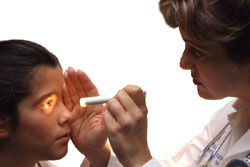
When exposed to light
When exposed to light, the concentration of cGMP is decreased through a series of biochemical steps triggered by photopigment activation. The reduction in cGMP causes the Na+ channels to close, stopping the Na+ leak, which leads to the voltage of the photoreceptors becoming more negative. This closes the voltage activated Ca2+ channels and reduces the neurotransmitter release.
The brighter the light, the greater the response and therefore the greater reduction in neurotransmitter release.
Further processing of light by the retina
The retina therefore signals the brain about light stimulation through an inhibitory response involving a series of physiological reactions, as shown in the figure below.
Action potentials, which are spikes of electrical discharges travelling along the cell surface, only originate in the ganglion cells, which are the first neurons in the chain that carry the visual stimuli to the brain. The following diagram illustrates the events that occur in a photoreceptor in response to light, initiating an action potential in the visual pathway. This process is called phototransduction:
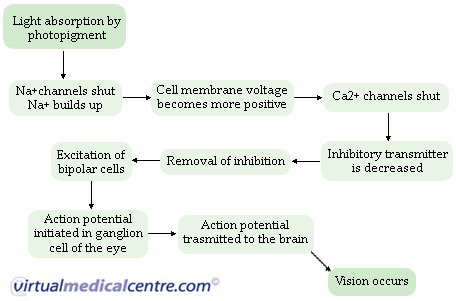
Development of the eye
Lens, retina and cornea

The outer layer of the optic cup forms a single layer of pigmented cells. Pigmentation begins at the end of Week 5 of development. The inner layer undergoes a complex differentiation into the various layers of the neural retina.
By the 7th month, the rod, cone, bipolar, and ganglion cells are present. As the lens placode folds inwards, it leads to the formation of part of the lens. By the 5th week of development, this thickens to form part of the cornea.
Blood supply to the eye
Choroid fissures, which are grooves in the choroid of the eye, start to develop along the lower surface of each optic cup. These fissures enable the hyaloids artery to reach the inner chamber of the eye, supplying it with blood. It also supplies the optic cup, lens vesicle, and embryonic tissue within the optic cup. Blood is returned from these structures via the hyaloids vein.
Some portions of the hyaloids vessels remain as the central artery and vein, but others degenerate during development.
Pupil
By the end of the 7th week, the edges of the choroid fissure fuse, forming an opening over the lens that will go on to form the pupil.
Iris
The optic cup grows during the 3rd month to give rise to the ciliary body and future iris. Both layers of the iris are become pigmented. However, only the outer layer of the ciliary body is pigmented. The iris is a light blue colour at birth in fair people with fair skin because of the absence of pigment.
The following table shows the embryonic sources of the individual structures of the eye:
| Surface ectoderm |
|
| Neural ectoderm |
|
| Mesoderm |
|
Ageing changes of the eye
Presbyopia
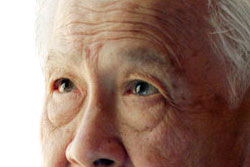
Cells in the centre of the lens are particularly vulnerable to damage because not only are they the oldest cells, but they are also the furthest away from the lens’s nutrient source, the aqueous humour. As age advances, these non-renewable central cells die and become stiff. As the cells lose their elasticity, the lens is unable to assume the spherical shape needed to accommodate for near vision.
Corrective lenses (i.e. reading glasses) are generally used to correct this problem.
Cataract
The loss of transparency of the lens or its capsule is known as a cataract, and is commonly associated with ageing. It can be caused by changes in lens conformation or the cross-linking of proteins. Cataracts may also be related to disease processes, metabolic conditions, hereditary disorders, trauma, or exposure to a deleterious agent such as ultraviolet radiation.
If they significantly impair vision, cataracts can be corrected through surgery by removing the lens and replacing it with a plastic lens in the posterior chamber.
Macular degeneration
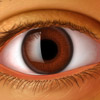 |
For information on age related macular degeneration, including the effect of smoking, exercise and nutrition on eyes, as well as some useful animations and tips to keep eyes healthy, see Macular Degeneration. |
References
- Ross MH, Pawlina W. Histology: A Text and Atlas (5th edition). Baltimore: Lipponcott Williams and Wilkins; 2006.
- Saladin KS. Anatomy and Physiology: The Unity of Form and Function (3rd edition). New York: McGraw-Hill; 2004.
- Sherwood LS. Human Physiology: From Cells to Systems (5th edition). Belmont: Brooks Cole Thomson Learning; 2004.
All content and media on the HealthEngine Blog is created and published online for informational purposes only. It is not intended to be a substitute for professional medical advice and should not be relied on as health or personal advice. Always seek the guidance of your doctor or other qualified health professional with any questions you may have regarding your health or a medical condition. Never disregard the advice of a medical professional, or delay in seeking it because of something you have read on this Website. If you think you may have a medical emergency, call your doctor, go to the nearest hospital emergency department, or call the emergency services immediately.


